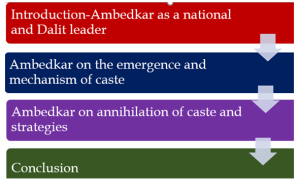Ques. Discuss Ambedkar’s views on Caste in India and its Annihilation.
Answer
- B.R. Ambedkar is one of the leading progressive, liberal thinkers of India whose contributions to making of Indian Constitution and its mandate of a social revolution are unparalleled.
- Dhananjay Keerregards Ambedkar is among the foremost leader of Dalits in India who played a critical role on raising dalit conciseness. In his work, ‘Castes in India: Their Mechanism, Genesis and Development’, Ambedkar identifies caste as an important institution, which is practiced by no other civilized society, past or contemporary.
- Ambedkar noted that the ancient Hindu society was composed of classes– Brahmans, the Kshatriya, the Vaishayas and the Shudrasthat became self-closed units called castes through the practice of endogamy.but roped in other features such as division of labour, absence of inter-dining and the principle of birth as well.
- Gopal Gurutalks of Ambedkar’s argument wherein even in Vedic times, people self-identified as per their caste rather as Hindus. This hierarchical social order was purposefully used to keep a section of population in a state of illiteracy, poverty and oppression.
- The worst of caste system was reflected in the practice of untouchability which used the notions of purity and pollution to keep an untouchable outside the fold of social interaction.
- He did not subscribe to the position that untouchability has its basis in race. He saw it as a social institution defended by the ideology of Brahmanismas propounded in his ‘broken men thesis’.
- Unlike Gandhi who sought to reform caste system, Ambedkar propounded its complete annihilation of caste for the emancipation of Dalits. However, the strategy for liberation argues Jaffrelotwitnessed oscillation between two methods.
- One was the promotion of the Untouchables in Hindu society or in the Indian nation as a whole; and the second strategy of a break that could take the form of a separate electorate, or of a separate Dalit party and/or of conversion outside Hinduism.
- While the first method was imbibed in the Constitutional practices of equality and rights for the Dalits, the second strategy was concretised in his monograph titled ‘Annihilation of Caste’. Valerian Rodriguesremarks that Ambedkar believed caste to have destroyed public spirit and was a blot on Hinduism.
- Ambedkar explored a variety of mechanisms to abolish class including promotion inter-dining but most importantly inter-marriage to break through caste silos. Eventually Ambedkar came to believe that annihilation of caste was not possible while remaining in the Hindu fold. Guru believes that Ambedkar’s conversion to Buddhism was a final strategy to create ‘negative’ consciousness among Dalitsagainst the hegemony of Brahminism and end the menace of caste, a fight that is still ongoing in India.




